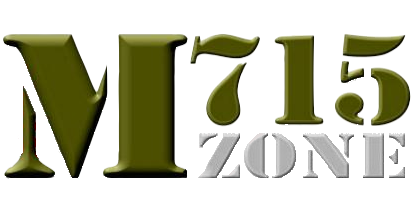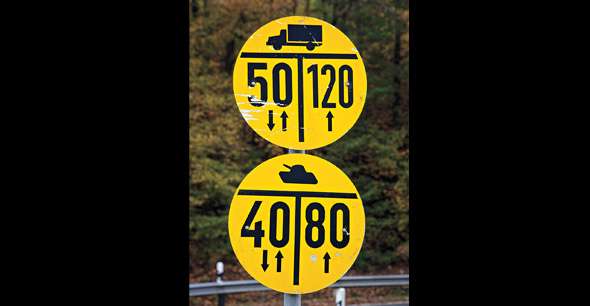Every time I take my truck to an event, someone asks about the yellow number disk on the front of my ‘715. There have been discussions here on the zone as well as “that other MV site” about these. Many owners know the older yellow plates and the newer desert tan or subdued plates have to do with the weight of the vehicle for bridges but actually, it goes beyond just weight and bridges as will be discussed later.
Our M-715’s normally carried a “4” and a “C” (cross country) but depending on the movement of the vehicle it can be a “5” if pulling a trailer and even an “H” and “6” if pulling a trailer on the highway only. There is even an “E” and “2” for emergencies like rapid advancement or retreating but I doubt you would take the time to change the number if running for your life!
How all this came about was never discussed here as far as I can find. It may well be old news to some so forgive this old SFC for boring you.
A retired Army Corp of Engineers Major friend of mine is writing his memoirs and sends me pages as they are completed. He served from WW2 till the 60’s when he retired. He currently lives with his German wife in Germany and is now 88. The latest chapter on his several post war Germany tours tells some of how this all “bridge plate” marking started. Keep in mind, NATO was doing this all over Europe, not just Germany. Other information below was researched by me. First a few paragraphs from the Majors’ memoirs;
“For several years after the war, NATO was in the process of establishing a military classification of fixed bridges in Germany as well as all NATO military vehicles, for compatibility purposes. The purpose was to inform military commanders which routes were capable of safely transporting their unit's vehicles and equipment. This process was especially critical during the "Cold War" for the movement of tanks, tank retrievers, heavy engineer equipment, etc. Some engineering units were assigned the task of calculating the "live load" of all vehicles and equipment in NATO units and applying a classification code number for them. Combat units then had to attach a small, yellow metal sign to their equipment bearing the items' classification number in black. NATO Engineer units had to visit every bridge and determine the bridge's width and length and calculate the live load capacity under different situations (i.e., one-way traffic by either extra wide or normal width vehicles, and two-way traffic). A yellow metal sign was posted at both approaches to the bridge bearing the bridge's classification in black. Those signs are still mounted at all bridges in Germany, and most Germans today have no idea of their significance. As the 7th Army's Engineer Maps and Survey Officer, I had to make certain that military maps in the 7th Army area were up to date, showing the classification code on all bridges shown on the maps. This required coordination with the Topographic Engineers of USAREUR, V Corps, VII Corps and the German Army. A typical bridge sign in Germany is pictured below”S
Not many of us here on the Zone have seen these signs on European bridges. I have because of my years of work throughout Europe and I’m sure Don Cavy did during his Germany tour. Don may have comments on this post as well.
NATO developed standards (STANAG) for classifying vehicles, bridges, ferries and the like. A few comments from the older NATO Standard #2020;
Military Load Classification (MLC)
Section 3
a. The procedures detailed in this document gives a standard method of enabling bridges, ferries, rafts (including their landing stages) and laden vehicles to be allocated a MLC number indicating the relationship between the load carrying capacity of the former and the effect produced by the latter.
THE MILITARY LOAD CLASSIFICATION NUMBER IS ONLY A NUMBER;b. If the vehicle MLC is less than or equal to the MLC of the bridge, ferry or raft (and of its landing stage), the vehicle can cross the bridge or be embarked on the ferry or raft; otherwise it must be diverted. It may eventually cross in conditions defined in paragraph c.
IT DOES NOT REPRESENT THE MASS OF THE VEHICLE
c. Under exceptional operational conditions, this prohibition may be lifted on special decision of the theatre commander in the operational zone, or on that of the civil authorities in areas under their control.
The entire NATO document can be viewed here and contains 66 pages of everything you want to know about bridges and vehicle classifications’!!!
http://contracting.tacom.army.mil/ss...20attach13.pdf
As you can see, the weight of the vehicle is not the only factor for assigning a MLC. If you read the NATO document you can see all the calculations that go into the number including wheel base, tire and axel load. For tracked vehicles, vibration also is critical.
So, as mentioned in paragraph “C” above, if you and/or your convoy add up to less then the number on the bridge sign, you can cross. As an example, in the bridge sign picture above it shows “50” for two way vehicle traffic. This translates to 10 vehicles with a MLC of “5” can be on the bridge if some are going each way. If one way traffic in the center of the bridge, 24 vehicles of MLC “5” can be on the bridge. A bridge captain would be posted at each approach to keep the numbers adding up correctly.
I hope you find this interesting and it ends up in the archives or as a “sticky” for future reference.
© Ronald L Boltz, 2013









 SFC, HQ,129th Sig Co, PAARNG, Vietnam Era
SFC, HQ,129th Sig Co, PAARNG, Vietnam Era
 Reply With Quote
Reply With Quote
